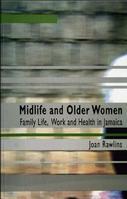
-WINSTON SILL/FREELANCE PHOTOGRAPHERDR. DENISE Eldemire Shearer, head of the Department of Community Health and Psychiatry and director of Mona Ageing and Wellness Centre, University of the West Indies (UWI), Jamaica, says Midlife and Older Women is, "A
timely publication which
focuses attention on an important aspect of the ageing issue midlife and 'young' old women."
The concern of this study done by Joan Rawlins was women 50-74 years. Women are considered to be in midlife at 50-59 years old, and older at 60-74. It has been something of an unveiling of the lives of Jamaican women aged 50-74 years. The author says that, "The lot of older Jamaican women, especially the working-class women, might be hard, but this research experience convinced me that the women about whom the book is written obtained a great deal of satisfaction from the contribution they made ..."
ABOUT THE AUTHOR
Joan M. Rawlins is senior lecturer and head of the Public Health and Primary Care Unit, Department of Para-clinical Sciences, Faculty of Medical Sciences, UWI, Trinidad and Tobago.
Jamaica is a society of extremes, in which there are great disparities between the life situations of the rich and the poor. It is a very class-divided society with 10 per cent of the population living in luxury, while the poorest 10 per cent struggle each day to eke out a living.
Rawlins identified two
communities, less than
three miles apart, for the
study August Town, a
traditional working class
community, and Hope
Pastures, an established middle-class community.
HIGHLIGHTS INTELLECTUAL
AND THEORETICAL ISSUES
This book seeks to provide information on this important, but relatively unresearched, topic in the Caribbean. The new knowledge highlights intellectual and theoretical issues not previously raised, and so should contribute to the literature on women. The book will be of particular interest to sociologists, anthropologists, social workers and labour, health and welfare workers.
In particular, it demonstrates the inadequacy of existing conceptions of 'power' in explaining the situation of this group of older women.
The women who were interviewed were pleased that someone was concerned about them, and expressed the hope that the research will draw attention to 'midlife and older women', and the society will become more responsive in terms of its obligations to them as a group.
CHAPTERS
There are five chapters in the book.
Chapter 1: The research for this book was done from 1990-91. In 1990 women 50-74 years old were approximately 12 per cent (142,940) of the total female population. These 'older women' were severely disadvantaged by the policies of structural adjustment. The Jamaican economy changed dramatically during the lifetime of these women who are the focus of the research. They, especially those of the working class and lower middle class, tried to cope, but had grave
economic difficulties.
Chapter 2: There were not as many differences as there were similarities by class for these women. Middle-class women as well as working-class women accepted the dominant discourse's portrayal of them as caregivers. The women played numerous roles within their families and interacted in a variety of relationships with them.
Chapter 3: Many women in the survey expressed dissatisfaction with their never-ending low status. Some women from the middle class found their lives rewarding, but most from both groups found that despite their best efforts, they still experienced life as short-changing them.
Chapter 4: The conclusion is that women get to this stage in good or bad health depending on the kind of life they have lived, the amount of stress in their lives, the kind of diet to which they had access and the kind of health care that had been available to them many years previously.
Chapter 5: Widowhood enabled some women to become more resourceful and take greater control of their lives. Some felt empowered because of their control of their time and money.
The author feels there is an urgent need for a shift in relation to society's view of this group of women.
Midlife and Older Women:
Family Life, Work and Health in Jamaica
Author: Joan Rawlins
Reviewer: Barbara Nelson
Publisher: University of the West Indies Press

